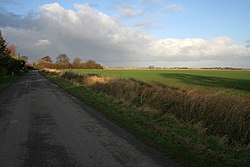Difference between revisions of "Gedney Broadgate"
(Created page with "{{Infobox town |name=Gedney Broadgate |county=Lincolnshire |picture=Hunt's Gate, Gedney Broadgate - geograph.org.uk - 619781.jpg |picture caption=Hunts Gate, view t...") |
m (→top: clean up, replaced: medieval → mediæval) |
||
| Line 17: | Line 17: | ||
[[File:Lincolnshire Fens - geograph.org.uk - 619770.jpg|left|thumb|200px|Looking towards Harford Gate, Gedney Broadgate]] | [[File:Lincolnshire Fens - geograph.org.uk - 619770.jpg|left|thumb|200px|Looking towards Harford Gate, Gedney Broadgate]] | ||
| − | Gedney Bargate was established after the Norman Conquest of 1066.<ref>Wagret, Paul; ''Polderlands'', p. 33, Methuen (1968). {{ISBN|0416427006}}</ref> At Gedney Bargate was the start point of the earliest | + | Gedney Bargate was established after the Norman Conquest of 1066.<ref>Wagret, Paul; ''Polderlands'', p. 33, Methuen (1968). {{ISBN|0416427006}}</ref> At Gedney Bargate was the start point of the earliest mediæval post-Conquest [[The Great Fen|fen]] dyke (sea defence bank): it is mentioned in a 1226-27 charter.<ref>Hallam, Herbert, Enoch; ''Settlement and Society. A Study of the Early Agrarian History of South Lincolnshire'', p. 18. (Cambridge University Press, 1965)</ref> |
By 1839 there existed a Baptist chapel in the hamlet,<ref>{{cite book|last=Robinson|first= W.|title=The General Baptist Repository and Missionary Observer|volume= 4|page=164 |origyear= Original publication 1842 |year=2012|edition=reprint|isbn=9781276287524 |publisher=Nabu (reprinter)}}</ref> which closed in 1986.<ref>{{cite web |url=http://parishes.lincolnshire.gov.uk/Gedney/section.asp?docId=60027 |title=Biography of Joyce Waterfall|publisher=Lincolnshire county council |year=2008 |accessdate=13 April 2013}}</ref> Pevsner mentions the 1839 chapel and the existence of "a couple of 18th-century cottages, one still thatched," and Broadgate House, dated 1824.<ref>{{Pevsner|p=230}}</ref> The thatched cottage, at Harford Gate, is a mid-18th-century rendered red-brick Grade II listed building.<ref>{{NHLE|1064579|The Thatched Cottage|grade=II}}</ref> A further Grade II listed building is the mid-18th-century red-brick Pulvertoft Hall at Harford Gate.<ref>{{NHLE|1359234|Pulvertoft Hall|grade=II}}</ref> | By 1839 there existed a Baptist chapel in the hamlet,<ref>{{cite book|last=Robinson|first= W.|title=The General Baptist Repository and Missionary Observer|volume= 4|page=164 |origyear= Original publication 1842 |year=2012|edition=reprint|isbn=9781276287524 |publisher=Nabu (reprinter)}}</ref> which closed in 1986.<ref>{{cite web |url=http://parishes.lincolnshire.gov.uk/Gedney/section.asp?docId=60027 |title=Biography of Joyce Waterfall|publisher=Lincolnshire county council |year=2008 |accessdate=13 April 2013}}</ref> Pevsner mentions the 1839 chapel and the existence of "a couple of 18th-century cottages, one still thatched," and Broadgate House, dated 1824.<ref>{{Pevsner|p=230}}</ref> The thatched cottage, at Harford Gate, is a mid-18th-century rendered red-brick Grade II listed building.<ref>{{NHLE|1064579|The Thatched Cottage|grade=II}}</ref> A further Grade II listed building is the mid-18th-century red-brick Pulvertoft Hall at Harford Gate.<ref>{{NHLE|1359234|Pulvertoft Hall|grade=II}}</ref> | ||
Revision as of 12:36, 30 January 2021
| Gedney Broadgate | |
| Lincolnshire | |
|---|---|
 Hunts Gate, view toward Harford gate | |
| Location | |
| Grid reference: | TF404223 |
| Location: | 52°46’50"N, 0°4’52"E |
| Data | |
| Post town: | Spalding |
| Postcode: | PE12 |
| Dialling code: | 01406 |
| Local Government | |
| Council: | South Holland |
| Parliamentary constituency: |
South Holland and The Deepings |
Gedney Broadgate is a hamlet in the parish of Gedney, in Holland, the south-eastern part of Lincolnshire. It is to be found close by the A17 road, a mile south of Gedney itself, and a mile and a half west from Long Sutton. It includes the area known as Harford Gate.
Gedney Bargate was established after the Norman Conquest of 1066.[1] At Gedney Bargate was the start point of the earliest mediæval post-Conquest fen dyke (sea defence bank): it is mentioned in a 1226-27 charter.[2]
By 1839 there existed a Baptist chapel in the hamlet,[3] which closed in 1986.[4] Pevsner mentions the 1839 chapel and the existence of "a couple of 18th-century cottages, one still thatched," and Broadgate House, dated 1824.[5] The thatched cottage, at Harford Gate, is a mid-18th-century rendered red-brick Grade II listed building.[6] A further Grade II listed building is the mid-18th-century red-brick Pulvertoft Hall at Harford Gate.[7]
See also
- Gedney
- Gedney Drove End
- Gedney Dyke
- Gedney Hill
- Gedney Marsh
- Gedney Church End
Outside links
| ("Wikimedia Commons" has material about Gedney Broadgate) |
References
- ↑ Wagret, Paul; Polderlands, p. 33, Methuen (1968). ISBN 0416427006
- ↑ Hallam, Herbert, Enoch; Settlement and Society. A Study of the Early Agrarian History of South Lincolnshire, p. 18. (Cambridge University Press, 1965)
- ↑ Robinson, W. (2012) [Original publication 1842]. The General Baptist Repository and Missionary Observer. 4 (reprint ed.). Nabu (reprinter). p. 164. ISBN 9781276287524.
- ↑ "Biography of Joyce Waterfall". Lincolnshire county council. 2008. http://parishes.lincolnshire.gov.uk/Gedney/section.asp?docId=60027. Retrieved 13 April 2013.
- ↑ Nikolaus Pevsner: The Buildings of England: Lincolnshire, 1964; 1989 Penguin Books ISBN 978-0-300-09620-0page 230
- ↑ National Heritage List 1064579: The Thatched Cottage (Grade II listing)
- ↑ National Heritage List 1359234: Pulvertoft Hall (Grade II listing)
